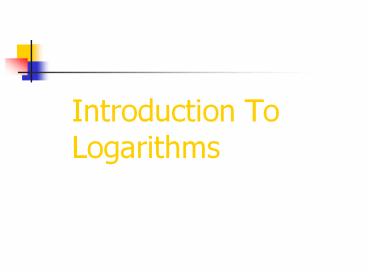Introduction%20To%20Logarithms - PowerPoint PPT Presentation
Title:
Introduction%20To%20Logarithms
Description:
then try multiplying. 2,234,459,912 and 3,456,234,459. Without a ... Our first job is to try to make some sense of logarithms. Our first question then must be: ... – PowerPoint PPT presentation
Number of Views:141
Avg rating:3.0/5.0
Title: Introduction%20To%20Logarithms
1
Introduction To Logarithms
2
Logarithms were originally developed to simplify
complex arithmetic calculations. They were
designed to transform multiplicative processes
into additive ones.
3
If at first this seems like no big deal, then
try multiplying 2,234,459,912 and
3,456,234,459. Without a calculator !
Clearly, it is a lot easier to add these two
numbers.
4
Today of course we have calculators and
scientific notation to deal with such large
numbers. So at first glance, it would seem
that logarithms have become obsolete.
5
Indeed, they would be obsolete except for one
very important property of logarithms. It is
called the power property and we will learn
about it in another lesson. For now we need
only to observe that it is an extremely important
part of solving exponential equations.
6
Our first job is to try to make some sense of
logarithms.
7
Our first question then must be
What is a logarithm ?
8
Of course logarithms have a precise mathematical
definition just like all terms in mathematics.
So lets start with that.
9
Definition of Logarithm
Suppose bgt0 and b?1, there is a number p such
that
10
Now a mathematician understands exactly what that
means.
But, many a student is left scratching their head.
11
The first, and perhaps the most important step,
in understanding logarithms is to realize that
they always relate back to exponential equations.
12
You must be able to convert an exponential
equation into logarithmic form and vice versa.
So lets get a lot of practice with this !
13
Example 1
Solution
We read this as the log base 2 of 8 is equal to
3.
14
Example 1a
Solution
Read as the log base 4 of 16 is equal to 2.
15
Example 1b
Solution
16
Okay, so now its time for you to try some on
your own.
17
Solution
18
Solution
19
Solution
20
It is also very important to be able to start
with a logarithmic expression and change this
into exponential form. This is simply the
reverse of what we just did.
21
Example 1
Solution
22
Example 2
Solution
23
Okay, now you try these next three.
24
Solution
25
Solution
26
Solution
27
We now know that a logarithm is perhaps best
understood as being closely related to
an exponential equation. In fact, whenever we
get stuck in the problems that follow we will
return to this one simple insight. We might even
state a simple rule.
28
When working with logarithms, if ever you get
stuck, try rewriting the problem in exponential
form.
Conversely, when working with exponential
expressions, if ever you get stuck,
try rewriting the problem in logarithmic form.
29
Lets see if this simple rule can help us solve
some of the following problems.
30
Solution
Lets rewrite the problem in exponential form.
Were finished !
31
Solution
Rewrite the problem in exponential form.
32
Example 3
Solution
Try setting this up like this
Now rewrite in exponential form.
33
These next two problems tend to be some of the
trickiest to evaluate. Actually, they are
merely identities and the use of our simple
rule will show this.
34
Example 4
Solution
First, we write the problem with a variable.
Now take it out of the logarithmic form and
write it in exponential form.
35
Example 5
Solution
First, we write the problem with a variable.
Now take it out of the exponential form and
write it in logarithmic form.
36
Ask your teacher about the last two examples.
They may show you a nice shortcut.
37
Finally, we want to take a look at the Property
of Equality for Logarithmic Functions.
Basically, with logarithmic functions, if the
bases match on both sides of the equal sign ,
then simply set the arguments equal.
38
Example 1
Solution
Since the bases are both 3 we simply set the
arguments equal.
39
Example 2
Solution
Since the bases are both 8 we simply set the
arguments equal.
Factor
continued on the next page
40
Example 2 continued
Solution
It appears that we have 2 solutions here. If we
take a closer look at the definition of a
logarithm however, we will see that not only must
we use positive bases, but also we see that the
arguments must be positive as well. Therefore -2
is not a solution. Lets end this lesson by
taking a closer look at this.
41
Our final concern then is to determine why
logarithms like the one below are undefined.
Can anyone give us an explanation ?
42
One easy explanation is to simply rewrite this
logarithm in exponential form. Well then see
why a negative value is not permitted.
First, we write the problem with a variable.
Now take it out of the logarithmic form and
write it in exponential form.
What power of 2 would gives us -8 ?
Hence expressions of this type are undefined.
43
That concludes our introduction to logarithms. In
the lessons to follow we will learn some
important properties of logarithms. One of these
properties will give us a very important tool
which we need to solve exponential equations.
Until then lets practice with the basic
themes of this lesson.

